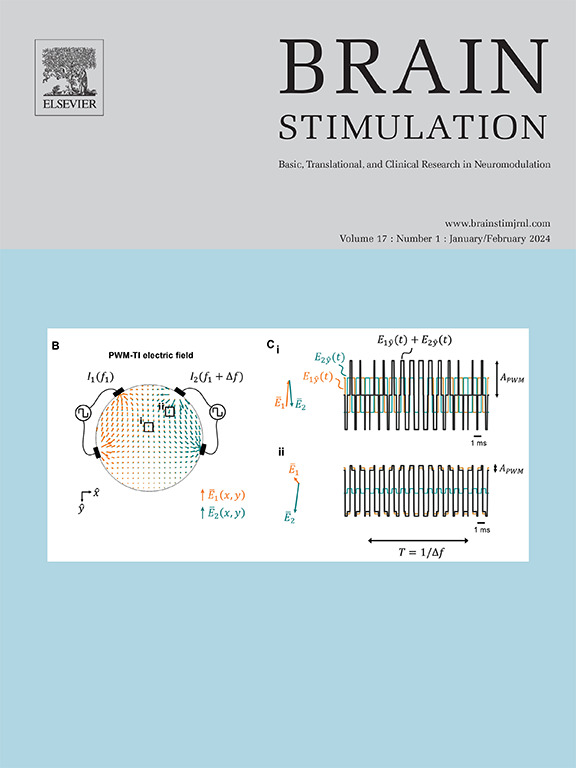Pulsed inhibition of corticospinal excitability by the thalamocortical sleep spindle
IF 7.6
1区 医学
Q1 CLINICAL NEUROLOGY
引用次数: 0
Abstract
Thalamocortical sleep spindles, i.e., oscillatory bursts at ∼12–15 Hz of waxing and waning amplitude, are a hallmark feature of non-rapid eye movement (NREM) sleep and believed to play a key role in memory reactivation and consolidation. Generated in the thalamus and projecting to neocortex and hippocampus, they are phasically modulated by neocortical slow oscillations (<1 Hz) and in turn phasically modulate hippocampal sharp-wave ripples (>80 Hz). This hierarchical cross-frequency nesting, where slower oscillations group faster ones into certain excitability phases, may enable phase-dependent plasticity in the neocortex, and spindles have thus been considered windows of plasticity in the sleeping brain. However, the assumed phasic excitability modulation had not yet been demonstrated for spindles. Utilizing a recently developed real-time spindle detection algorithm, we applied spindle phase-triggered transcranial magnetic stimulation (TMS) to the primary motor cortex (M1) hand area to characterize the corticospinal excitability profile of spindles via motor evoked potentials (MEP). MEPs showed net suppression during spindles, driven by a “pulse of inhibition” during its falling flank with no inhibition or facilitation during its peak, rising flank, or trough. This unidirectional (“asymmetric”) modulation occurred on top of the general sleep-related inhibition during spindle-free NREM sleep and did not extend into the refractory post-spindle periods. We conclude that spindles exert “asymmetric pulsed inhibition" on corticospinal excitability. These findings and the developed real-time spindle targeting methods enable future studies to investigate the causal role of spindles in phase-dependent synaptic plasticity and systems memory consolidation during sleep by repetitively targeting relevant spindle phases.
丘脑皮层睡眠纺锤体对皮质脊髓兴奋性的脉冲抑制。
丘脑皮质睡眠纺锤波,即在约12-15赫兹的振幅起伏的振荡爆发,是非快速眼动(NREM)睡眠的一个标志性特征,被认为在记忆的重新激活和巩固中起着关键作用。它们产生于丘脑并投射到新皮层和海马体,由新皮层慢振荡(80 Hz)进行相位调节。这种分层的交叉频率嵌套,其中较慢的振荡将较快的振荡分组到某些兴奋性阶段,可能使新皮层的相位依赖可塑性成为可能,因此纺锤波被认为是睡眠大脑的可塑性窗口。然而,假定的相激性调制尚未在纺锤体中得到证实。利用最近开发的实时纺锤波检测算法,我们将纺锤波相位触发经颅磁刺激(TMS)应用于初级运动皮层(M1)手部区域,通过运动诱发电位(MEP)表征纺锤波的皮质脊髓兴奋性特征。MEPs在纺锤波期间表现出净抑制,在其下降翼受到“抑制脉冲”的驱动,在其峰值,上升翼或低谷期间没有抑制或促进。这种单向(“不对称”)调节发生在无纺锤波的非快速眼动睡眠期间的一般睡眠相关抑制之上,并没有延伸到难耐的后纺锤波期。我们得出结论,纺锤波对皮质脊髓兴奋性施加“不对称脉冲抑制”。这些发现和已开发的实时纺锤波靶向方法使未来的研究能够通过重复靶向相关纺锤波相来研究纺锤波在睡眠期间相依赖性突触可塑性和系统记忆巩固中的因果作用。
本文章由计算机程序翻译,如有差异,请以英文原文为准。
求助全文
约1分钟内获得全文
求助全文
来源期刊

Brain Stimulation
医学-临床神经学
CiteScore
13.10
自引率
9.10%
发文量
256
审稿时长
72 days
期刊介绍:
Brain Stimulation publishes on the entire field of brain stimulation, including noninvasive and invasive techniques and technologies that alter brain function through the use of electrical, magnetic, radiowave, or focally targeted pharmacologic stimulation.
Brain Stimulation aims to be the premier journal for publication of original research in the field of neuromodulation. The journal includes: a) Original articles; b) Short Communications; c) Invited and original reviews; d) Technology and methodological perspectives (reviews of new devices, description of new methods, etc.); and e) Letters to the Editor. Special issues of the journal will be considered based on scientific merit.
 求助内容:
求助内容: 应助结果提醒方式:
应助结果提醒方式:


